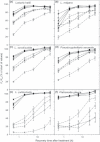The paradox of higher light tolerance during desiccation in rare old forest cyanolichens than in more widespread co-occurring chloro- and cephalolichens
- PMID: 22762452
- PMCID: PMC3593164
- DOI: 10.1111/j.1469-8137.2012.04221.x
The paradox of higher light tolerance during desiccation in rare old forest cyanolichens than in more widespread co-occurring chloro- and cephalolichens
Abstract
Desiccation tolerance was quantified in four cyanolichens (Lobaria hallii, Lobaria retigera, Lobaria scrobiculata, Pseudocyphellaria anomala), one cephalolichen (Lobaria pulmonaria) and one chlorolichen (Platismatia glauca) from xeric and mesic, open and closed North American boreal forests. These sympatric epiphytes were exposed to 0%, 33%, 55% and 75% relative humidity with or without medium light (200 μmol m⁻² s⁻¹) for 7 d. Permanent and temporary photoinhibitory damage was recorded as viability measures. All species tolerated well the drying in darkness, but L. hallii and L. retigera, associated with a very humid climate, showed minor damage at the hardest drying (silica gel). Simultaneous exposure to medium light severely aggravated the drying damage at all relative humidity levels. Combined drying-light exposure was particularly devastating for the widespread chloro- and cephalolichens, whereas cyanolichens, including rare old forest species, were fairly resistant. The ability to recover after combined drying-light stress (this study) correlated positively with increasing species-specific water holding capacities (from the literature). Cyanolichens, depending on liquid water and large internal water storage, probably require strong drying-light resistance to handle long periods between hydration events, whereas chlorolichens can regularly maintain their photosynthetic apparatus during frequent and rapid activation by humid air on clear mornings.
© 2012 The Authors. New Phytologist © 2012 New Phytologist Trust.
Figures




 = 0.469; P = 0.005). Open symbols, the chlorolichens Platismatia glauca (triangles apex up) and Lobaria pulmonaria (circles). Closed symbols, Pseudocyphellaria anomala (squares), Lobaria scrobiculata (triangles apex down), L. hallii (triangles apex up) and L. retigera (circles). Each error bar (vertical as well as horizontal) represents ± 1SE (n = 39–40 for WHC and n = 19–20 for Fv/Fm) from each type of habitat (see Table 3).
= 0.469; P = 0.005). Open symbols, the chlorolichens Platismatia glauca (triangles apex up) and Lobaria pulmonaria (circles). Closed symbols, Pseudocyphellaria anomala (squares), Lobaria scrobiculata (triangles apex down), L. hallii (triangles apex up) and L. retigera (circles). Each error bar (vertical as well as horizontal) represents ± 1SE (n = 39–40 for WHC and n = 19–20 for Fv/Fm) from each type of habitat (see Table 3).Similar articles
-
Functional trade-off of hydration strategies in old forest epiphytic cephalolichens.Fungal Biol. 2020 Oct;124(10):903-913. doi: 10.1016/j.funbio.2020.07.008. Epub 2020 Jul 30. Fungal Biol. 2020. PMID: 32948278
-
Old-growth forest versus generalist lichens: Sensitivity to prolonged desiccation stress and photosynthesis reactivation rate upon rehydration.Mycologia. 2024 Jan-Feb;116(1):31-43. doi: 10.1080/00275514.2023.2275460. Epub 2024 Jan 19. Mycologia. 2024. PMID: 38039398
-
Photoprotection of reaction centres in photosynthetic organisms: mechanisms of thermal energy dissipation in desiccated thalli of the lichen Lobaria pulmonaria.New Phytol. 2010 Jan;185(2):459-70. doi: 10.1111/j.1469-8137.2009.03064.x. Epub 2009 Oct 26. New Phytol. 2010. PMID: 19863730
-
Protection of the photosynthetic apparatus against damage by excessive illumination in homoiohydric leaves and poikilohydric mosses and lichens.J Exp Bot. 2001 Oct;52(363):1999-2006. doi: 10.1093/jexbot/52.363.1999. J Exp Bot. 2001. PMID: 11559735 Review.
-
Desiccation: An environmental and food industry stress that bacteria commonly face.Food Microbiol. 2018 Feb;69:82-88. doi: 10.1016/j.fm.2017.07.017. Epub 2017 Jul 24. Food Microbiol. 2018. PMID: 28941912 Review.
Cited by
-
Melanins from the Lichens Lobaria pulmonaria and Lobaria retigera as Eco-Friendly Adsorbents of Synthetic Dyes.Int J Mol Sci. 2022 Dec 9;23(24):15605. doi: 10.3390/ijms232415605. Int J Mol Sci. 2022. PMID: 36555244 Free PMC article.
-
Continuous monitoring of chlorophyll a fluorescence and microclimatic conditions reveals warming-induced physiological damage in biocrust-forming lichens.Plant Soil. 2023;482(1-2):261-276. doi: 10.1007/s11104-022-05686-w. Epub 2022 Sep 9. Plant Soil. 2023. PMID: 36714192 Free PMC article.
-
Interactive effects of drought and edge exposure on old-growth forest understory species.Landsc Ecol. 2022;37(7):1839-1853. doi: 10.1007/s10980-022-01441-9. Epub 2022 May 20. Landsc Ecol. 2022. PMID: 35795191 Free PMC article.
-
Specialized fungal parasites reduce fitness of their lichen hosts.Ann Bot. 2018 Jan 25;121(1):175-182. doi: 10.1093/aob/mcx124. Ann Bot. 2018. PMID: 29155927 Free PMC article.
-
The pattern of photosynthetic response and adaptation to changing light conditions in lichens is linked to their ecological range.Photosynth Res. 2023 Jul;157(1):21-35. doi: 10.1007/s11120-023-01015-z. Epub 2023 Mar 28. Photosynth Res. 2023. PMID: 36976446 Free PMC article.
References
-
- Adams WW, Demmig-Adams B, Rosenstiel TN, Brightwell AK, Ebbert V. Photosynthesis and photoprotection in overwintering plants. Plant Biology. 2002;4:545–557.
-
- Barták M, Solhaug KA, Vrábliková H, Gauslaa Y. Curling during desiccation protects the foliose lichen Lobaria pulmonaria against photoinhibition. Oecologia. 2006;149:553–560. - PubMed
-
- Beckett RP, Minibayeva FV, Vylegzhanina NN, Tolpysheva T. High rates of extracellular superoxide production by lichens in the suborder Peltigerineae correlate with indices of high metabolic activity. Plant, Cell & Environment. 2003;26:1827–1837.
-
- Belnap J, Lange OL. Lichens and microfungi in biological soil crusts: community structure, physiology, and ecological functions. In: Dighton J, White JF, Oudemans P, editors. The fungal community. Its organization and role in the ecosystem. Boca Raton, FL, USA: CRC Press; 2005. pp. 117–138.
-
- Bilger W, Rimke S, Schreiber U, Lange OL. Inhibition of energy-transfer to photosystem II in lichens by dehydration: different properties of reversibility with green and blue–green phycobionts. Journal of Plant Physiology. 1989;134:261–268.
MeSH terms
Substances
LinkOut - more resources
Full Text Sources

